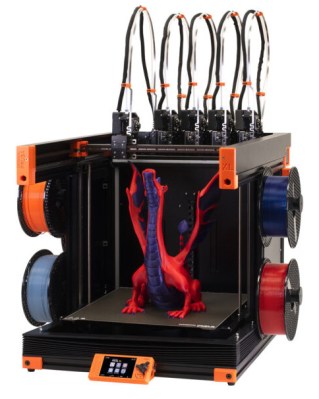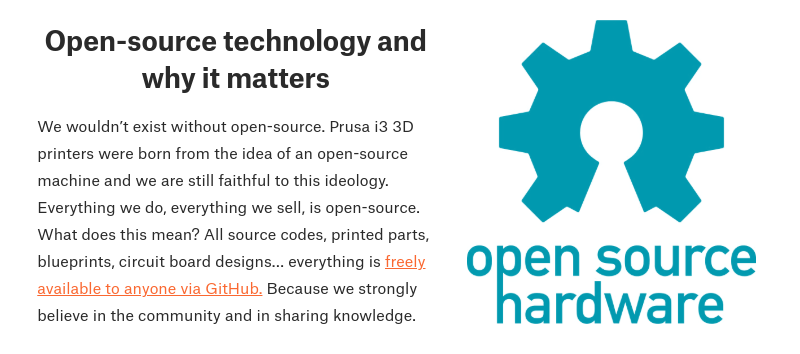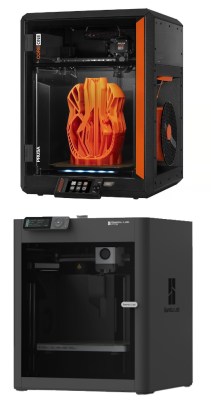
Yesterday, Prusa Research officially unveiled their next printer, the Core ONE. Going over the features and capabilities of this new machine, it’s clear that Prusa has kept a close eye on the rapidly changing desktop 3D printer market and designed a machine to better position themselves within a field of increasingly capable machines from other manufacturers.
While some saw the incremental upgrades of the i3 MK4 as being too conservative, the Core ONE ticks all the boxes of what today’s consumer is looking for — namely high-speed CoreXY movement with a fully enclosed chamber — while still offering the build quality, upgradability, and support that the company has built its reputation on. Put simply it’s one of the most exciting products they’ve introduced in a long time, and exactly the kind of machine that many Prusa fans have been waiting for.
Unfortunately, there’s one feature that’s ominously absent from the Core ONE announcement post. It’s easy to overlook, and indeed, most consumers probably won’t even know it’s missing. But for those of us who are concerned with such matters, it’s an unspoken confirmation that an era has finally come to an end.
With the Core ONE, Prusa Research is no longer in the business of making open source 3D printer hardware, but that doesn’t mean that the printer isn’t hackable. It’s complicated, so read on.
Death by a Thousand Cuts
To say that Prusa Research pivoting away from the open source hardware (OSHW) principles that guided the company, and indeed the 3D printing community, through its early years is a disappointment would be quite an understatement. It’s a crushing blow. One which critics will use to call into question the viability of building a sustainable business model around OSHW. But it’s also not hard to see how we got to this point.

The first warning sign came back in 2021, with the announcement of the Prusa XL. With this new high-end printer, the company seemed uncharacteristically hesitant to open things up, which frankly wasn’t entirely unreasonable. The pricing of the XL put it closer into the professional market than a traditional hobbyist machine, and there were some new features like tool changing and a segmented heated bed that were unique enough that they’d want to keep the details under wraps until the machine at least got a foothold in the market. So if Prusa wanted to play this one a little closer to the chest, so be it.
But things took a concerning turn last year with the release of the i3 MK4. Although Prusa still called the printer open source in their marketing, the reality was a bit more complicated. While at least some of the printer’s technical information was made available, especially the elements that were inherited from the earlier i3 models, there were several rather large omissions.
Printable parts were available only as STLs, there were no design files released for the printer’s control board, and the Nextruder (which was introduced with the XL) remained all but completely proprietary. Many argued that the MK4 didn’t meet the standards that Prusa had set with their previous printers, and that continuing to call it open source was misleading.
If it wasn’t already obvious that Prusa’s commitment to open source was beginning to waiver, Josef’s post on the Prusa Blog made his position abundantly clear. Framed as a call for discussion, the post outlined his feelings on the open source community and what he perceived as the failures of common licenses such as the GPL. While he said that the company still intended to make their machines open, the writing was clearly on the wall.
A New Chapter for Prusa
To be clear, the Core ONE is of critical strategic importance to Prusa. The company needed a revamped machine to combat increased competition from Chinese printer manufacturers, and while it’s not being marketed as a replacement for the i3 MK4, it’s not hard to see the direction the market is moving in. The i3 is a workhorse, and won’t be going away anytime soon, but the chances that it will see a MK5 at this point seem exceptionally slim.

But the Core ONE also represents a mostly clean slate design, one that shares relatively little with the i3. This frees Prusa from any obligation, perceived or otherwise, to continue releasing the printer’s design files. Indeed, the term “open source” only appears once in the announcement post for the printer — and that’s when referring to the firmware and slicer code, which are.
Although we don’t have documentation or an assembly guide for the Core ONE or the MK4S->Core upgrade kits yet, it looks as if very little of Prusa’s remaining open source hardware has been brought forward.
Potentially the Core ONE is using some variation of the CC BY-SA 4.0 licensed MK52 magnetic heated bed, but beyond that, we already know that Prusa is still keeping the design files for major components such as the Nextruder and xBuddy 32-bit control board under wraps for the time being.
Not Open, But Hackable
So we know that Prusa isn’t advertising the Core ONE design as open source hardware, and that only limited technical data has been released for the few components and subsystems that it inherits from the XL and MK4S. But what does that actually mean for users like us?
That’s where things get a little tricky. While Prusa’s newer printers certainly do not meet the literal requirements of OSHW, they’re still remarkably transparent in a world of proprietary black boxes. We might not get the design files for the printed parts in these new machines, but you’ll get STLs that you can run off if you need a replacement. We can also be fairly sure that Prusa will continue their tradition of releasing wiring schematics for the Core ONE as they’ve done with essentially all of their previous printers, which is more than we can say for the vast majority of consumer products.
While the lack of design files for these new Prusa printers is unfortunate on a philosophical level, it’s hard to argue that they’re any less repairable, upgradable, or hackable than their predecessors. In fact, Prusa’s actually made at least one improvement in that department — announcing that breaking off the control board’s “Appendix” security device and installing a new firmware will no longer void the printer’s warranty.

We should also consider that even Prusa’s earlier printers have not always been as open as the company would perhaps like us to believe. Sure, for the Prusa Mini you could hop on GitHub and grab the KiCad files for its mainboard, and the design files for the i3 up until the MK3 are available as GPLv2 licensed OpenSCAD code. But the company has never actually provided a complete Bill of Materials for their printers, and even after years of requests from the community, they have still yet to release the source code for their bootloader as they consider it a separate project from the main GPL-licensed firmware.
Prusa has always used a somewhat piecemeal method of releasing the source and design files for their products. But it’s worked for them up to this point. The bottom line is, makers and hackers will still have plenty to work with, even if things aren’t quite as open as we’d prefer.
Becoming Your Own Enemy
On a personal note, I find myself conflicted. I’d argue that the i3 MK3 is one of the best purchases I’ve ever made, and there’s no doubt in my mind that the “Prusa Experience” — support, reliability, upgradability — is worth spending the extra money on. I’m also confident that the Core ONE is precisely the kind of machine Prusa needed to remain competitive in today’s market.

At the same time, there were issues that I was willing to overlook because the company was producing open source hardware. When a shipping date slipped, or a firmware update introduced a new issue, I let it slide because it was for the greater good. But now that they’re no longer calling their printers open source, I can’t help but feel some of that goodwill evaporating — and I’m probably not the only one having similar thoughts.
Ultimately, the part that bothers me the most about this change in Prusa’s approach is that it all seems predicated on a bogeyman that I’m not convinced actually exists. The company line is that releasing the source for their printers allows competitors to churn out cheap clones of their hardware — but where are they?
Let’s be honest, Bambu didn’t need to copy any of Prusa’s hardware to take their lunch money. You can only protect your edge in the market if you’re ahead of the game to begin with, and if anything, Prusa is currently playing catch-up to the rest of the industry that has moved on to faster designs. The only thing Prusa produces that their competitors are actually able to take advantage of is their slicer, but that’s another story entirely. (And of course, it is still open source, and widely forked.)
So will the Prusa Core ONE be a good printer? Almost certainly. Will I buy one? Very likely. But part of me will always be disappointed that the guy with the open source hardware logo tattoo took his ball and went home as soon as the game starting getting tough.
This articles is written by : Nermeen Nabil Khear Abdelmalak
All rights reserved to : USAGOLDMIES . www.usagoldmines.com
You can Enjoy surfing our website categories and read more content in many fields you may like .
Why USAGoldMines ?
USAGoldMines is a comprehensive website offering the latest in financial, crypto, and technical news. With specialized sections for each category, it provides readers with up-to-date market insights, investment trends, and technological advancements, making it a valuable resource for investors and enthusiasts in the fast-paced financial world.
